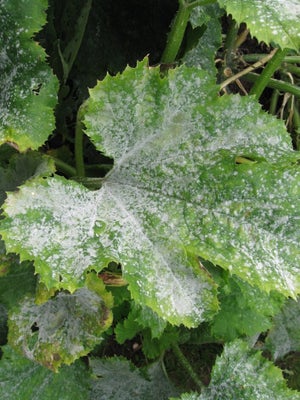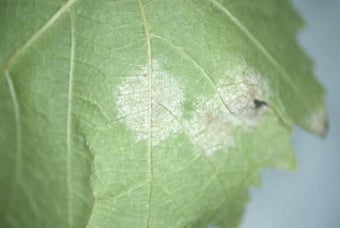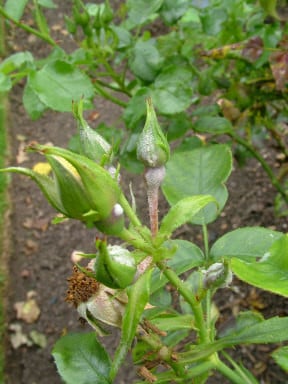
Quick facts
Common name - Powdery mildews
Scientific name - Various
Plants affected - Many plants
Main symptoms - White, dusty coating on leaves, stems and flowers
Caused by - Fungus
Timing - Spring onwards
What is powdery mildew?
is a fungal disease of the foliage, stems and occasionally flowers and fruit where a superficial fungal growth covers the surface of the plant.
Many common edible and ornamental garden plants are affected including apples, blackcurrants, gooseberries, grapes, crucifers, cucurbits (courgettes, marrows and cucumbers), peas, grasses (the powdery mildew fungi are major pathogens of cereal crops), Acanthus, delphiniums, phlox, many ornamentals in the daisy family, cherry and Portuguese laurels (Prunus laurocerasus and P. lusitanica), Lonicera (honeysuckle), rhododendrons and azaleas, roses and Quercus (oak).
Click on the links above to go to profiles of the disease on some of the common host plants.
Powdery mildews usually have narrow host ranges comprising of just a few related plants. For example, the powdery mildew affecting peas is a different species from the one attacking apples.
Symptoms
Take a look at the photo gallery below for pictures of symptoms on different host plants.
You may see the following symptoms:
- White, powdery spreading patches of fungus on upper or lower leaf surfaces, flowers and fruit
- Tissues sometimes become stunted or distorted, such as leaves affected by rose powdery mildew
- In many cases the affected tissues show little reaction to infection in the early stages, but in a few specific cases, for example on Rhamnus, the infection provokes a strong colour change in the infected parts, which turn a purple-brown colour
- Sometimes the fungal growth is sparse and difficult to see, despite discolouration of the affected plant tissues, e.g. powdery mildews on wisteria and on some rhododendron species

Control
The RHS believes that avoiding pests, diseases and weeds by good practice in cultivation methods, selection, and encouraging or introducing natural enemies, should be the first line of control. If chemical controls are used, they should be used only in a minimal and highly targeted manner.
Non-chemical control
Destroying fallen infected leaves in autumn will reduce the amount of infectious spores next spring. Promptly pruning out infected shoots will reduce subsequent infection.
Most fungi have a host range restricted to a relatively few, related plants, but these can include wild relatives which can be sources of infection, e.g. wild crab apples may be sources of infection for apple orchards.
Seed producers sometimes offer powdery mildew-resistant cultivars of both vegetables and ornamental plants, check catalogues for details.
Manage the environment around susceptible plants:
Choose the best location
- Plant in full sun where possible (the exception is shade-loving plants)
- Avoid sheltered places, such as against walls or fences, where the air is likely to be still
Manage the soil
- Provide good drainage, but water regularly during dry periods (plants suffering from regular but intermittent drought-stress are more susceptible). Application of mulch may help water retention
- Do not over-fertilise (especially not too much nitrogen) as succulent growth is particularly susceptible
Manage and leaf wetness
- Don’t plant too densely, giving space between plants. Aim for an open environment to increase air circulation and reduce humidity
- Prune shrubs to give an open structure (which will again improve air circulation and reduce humidity)
- Avoid overhead watering early in the morning or in the evening
- Overhead watering (in mid-morning) in dry weather can reduce powdery mildew (which does not like direct contact with water). Avoid leaves remaining wet for long as this may favour other diseases
Fungicides
The RHS recommends that you don't use fungicides. Fungicides (including organic types) may reduce , impact soil health and have wider adverse environmental effects. If you do intend to use a fungicide, please read the information given in the link and download below to ensure that use, storage and disposal of the product is done in a responsible and legally compliant manner.
The products listed in the ‘Fungicides for gardeners’ document below are legally available for use by home gardeners in the UK. This information is provided to avoid misuse of legal products and the use of unauthorised and untested products, which potentially has more serious consequences for the environment and wildlife than when products are used legally. Homemade products are not recommended as they are unregulated and usually untested.
Download
Fungicides for gardeners (Adobe Acrobat pdf document outlining fungicides available to gardeners)
Link
Biology
The majority of the growth of most powdery mildews is found on the plant surface. The fungus sends feeding structures into the surface cells, greatly reducing the vigour of the plant. Because of this surface growth, powdery mildews are even more influenced by the environment than other plant diseases. Choosing the right plant for the right place, along with some simple measures to adjust the environment can go a long way to minimising issues in gardens.
Powdery mildew fungi produce microscopic air-borne dispersal spores from the fungal growth on the plant surface. These have an unusually high water content, enabling them to infect under drier conditions than most other fungal pathogens.
High (but not free water) is, however, favourable for spore production and infection, and plants growing in areas with poor air flow (allowing the accumulation of humid, ‘stagnant’ air) are likely to be attacked. Thus climbers and ramblers grown against walls and fences are often heavily infected.
Powdery mildews either spend the winter as infections on green tissues, or as resting structures on fallen leaves which then release spores the following spring.




















